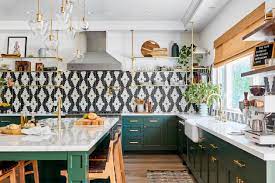A kitchen backsplash is not only a practical addition to your kitchen but also an opportunity to showcase your personal style and creativity. Whether you prefer sleek and modern tiles or rustic and handmade designs, tiling your kitchen backsplash allows you to enhance the aesthetic appeal of your space while protecting your walls from splashes and stains. In this guide, we’ll explore the art of tiling your kitchen backsplash, from selecting the right tiles to completing the installation process with finesse.
Introduction
The kitchen is often considered the heart of the home, and the backsplash serves as a focal point that ties the design elements together. Beyond its decorative function, the backsplash plays a crucial role in protecting the walls behind the sink, stove, and countertops from water damage, grease stains, and food splatters. Choosing the perfect tiles and installing them with precision can elevate the look of your kitchen and make a lasting impression on anyone who enters the space.
Choosing the Right Tiles
When selecting tiles for your kitchen backsplash, consider factors such as material, color, size, shape, and finish. Ceramic, porcelain, glass, and natural stone are popular options for kitchen backsplashes, each offering unique benefits in terms of durability, ease of maintenance, and visual appeal. Choose tiles that complement your kitchen’s style and color scheme while adding texture and visual interest to the space.
Preparing the Surface
Before you begin tiling, it’s essential to prepare the surface of the wall to ensure proper adhesion and longevity of the tiles. Start by cleaning the wall to remove any dirt, grease, or debris. Repair any cracks or holes in the drywall and sand the surface smooth. Apply a coat of primer to create a stable and uniform base for the tile adhesive.
Measuring and Planning
Measure the area of your backsplash to determine how many tiles you’ll need and where to start and end the tile installation. Use a level and chalk line to mark horizontal and vertical guidelines on the wall to ensure straight and even tile placement. Plan the layout of your tiles, taking into account any obstacles such as outlets, switches, and corners.
Gathering Tools and Materials
Gather all the necessary tools and materials for tiling your kitchen backsplash, including:
- Tiles
- Tile adhesive
- Grout
- Spacers
- Tile cutter or wet saw
- Trowel
- Grout float
- Tile spacers
- Level
- Rubber grout float
- Sponge
- Bucket
Having everything you need on hand will streamline the tiling process and help you achieve professional-looking results.
Installing the Tiles
Start by applying tile adhesive to the wall using a notched trowel, then press the tiles firmly into place, following your layout plan and using spacers to maintain consistent spacing between tiles. Continue tiling row by row, making any necessary cuts to fit tiles around obstacles and edges. Use a level to ensure that the tiles are straight and even as you work.
Cutting Tiles and Making Adjustments
When cutting tiles to fit around corners, outlets, or other obstacles, use a tile cutter or wet saw to make precise cuts. Take accurate measurements and use a pencil to mark where the cuts need to be made. Use tile nippers or a tile saw to carefully trim the tiles to size, ensuring a snug fit against walls and corners.
Grouting and Sealing
Once the tiles are in place and the adhesive has dried, remove the spacers and apply grout to the joints between the tiles using a grout float. Press the grout into the joints at a 45-degree angle, working in small sections at a time. Use a damp sponge to remove excess grout from the surface of the tiles and smooth the joints. Allow the grout to dry for the recommended time, then apply a sealer to protect the grout from stains and moisture.
Cleaning and Maintenance
To keep your tiled kitchen backsplash looking its best, clean it regularly with a mild detergent and warm water. Avoid abrasive cleaners that could damage the tiles or grout. Periodically inspect the grout for any signs of damage or discoloration and repair or replace it as needed. With proper care and maintenance, your tiled backsplash will remain a beautiful and functional addition to your kitchen for years to come.
Adding Finishing Touches
Enhance the look of your tiled kitchen backsplash by adding decorative accents such as border tiles, mosaic inserts, or contrasting trim pieces. Consider incorporating a focal point, such as a decorative medallion or mural, to add visual interest and personality to your backsplash. Experiment with different tile patterns, layouts, and color combinations to create a custom look that reflects your personal style.
Common Mistakes to Avoid
When tiling your kitchen backsplash, avoid common mistakes such as using the wrong type of adhesive or grout, failing to properly prepare the surface, or neglecting to seal the grout. Take your time and pay attention to detail to ensure a professional-looking result that enhances the overall appearance of your kitchen.
Cost Considerations
The cost of tiling your kitchen backsplash will depend on factors such as the type of tiles you choose, the size of the area to be tiled, and whether you plan to hire a professional installer. Ceramic and porcelain tiles are generally more affordable than natural stone or glass tiles, while handmade or artisanal tiles may come with a higher price tag. Factor in the cost of materials, tools, and labor when budgeting for your tiling project.
DIY vs. Hiring a Professional
Decide whether to tackle the tiling project yourself or hire a professional installer. While DIY tiling can save money and give you a sense of accomplishment, it requires time, patience, and attention to detail. Hiring a professional can ensure a faster and more efficient installation process, especially if you’re dealing with complex layouts or specialty tiles. Consider your skill level, available time, and budget when making this decision.
Inspiration and Design Ideas
Browse home improvement magazines, websites, and social media platforms for inspiration and design ideas for your kitchen backsplash. Consider popular trends such as subway tiles, geometric patterns, or bold colors to add a contemporary touch to your space. Experiment with different tile materials, finishes, and layouts to create a backsplash that reflects your unique style and personality.
Conclusion
Tiling your kitchen backsplash is a rewarding home improvement project that allows you to express your creativity and enhance the functionality and beauty of your kitchen. By choosing the right tiles, preparing the surface properly, and following the installation process step by step, you can achieve professional-looking results that will stand the test of time. Whether you prefer a classic subway tile backsplash or a bold mosaic design, the art of tiling your kitchen backsplash offers endless possibilities for customization and creativity.

